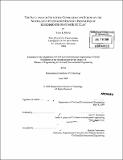The influence of effective consolidation stress on the normalized extension strength properties of resedimented Boston blue clay
Author(s)
Moniz, Safia R
DownloadFull printable version (34.85Mb)
Other Contributors
Massachusetts Institute of Technology. Dept. of Civil and Environmental Engineering.
Advisor
John T. Germaine.
Terms of use
Metadata
Show full item recordAbstract
The ability to accurately determine the undrained shear strength of cohesive soil is of particular importance to the practice of geotechnical engineering. Ladd & Foot (1974) presents a method to determine the undrained shear strength based on the concept of normalized soil parameters; called the SHANSEP (Stress History and Normalized Soil Engineering Properties) method. Recent research at MIT has discovered a consistant variation of undrained shear parameters during triaxial compression. Undrained triaxial compression tests on RBBC (Resedimented Boston Blue Clay) have shown that the soil stiffness and strength is dependant on the vertical consolidation effective stress and that the strength behaviour does not strictly conform to a normalized framework. The aim of this study is to explore the trend between vertical consolidation stress and the undrained shear strength behaviour in extension for cohesive soils to determine whether the normalized soil parameter concept (and hence SHANSEP) is still applicable at vertical consolidation stresses ranges of [sigma]'v 2 =/>10 ksc (1.OMPa). To do this, a series of Ko-consolidated undrained triaxial extension tests were performed at vertical consolidation consolidation stresses ranging from 1.5 ksc (0.15 MPa) to 20 ksc (2.0MPa). Results from these tests clearly show that the undrained shear strength decreases with vertical effective stress. The undrained shear strengths decreased from 0.17 ksc to 0.15 ksc, and the friction angle decreased from 45° to 31.1° corresponding to an increase in vertical consolidation stress level. (cont.) The results also show that the maximum secant modulus (Emax) was found to decrease exponentially with the vertical consolidation effective stress ([sigma]'vc) according to the equation: Emax = 450 x [sigma]'vc 0.74 This relationship was proposed by Santagata (1999) and was presented as: Emax [alpha] [sigma]'vc 0.74. There is not any apparent relationship between the lateral stress ratio and the vertical consolidation stress. The trends observed during shear in extension are consistent with observations made during Ko consolidation compression testing.
Description
Thesis (M. Eng.)--Massachusetts Institute of Technology, Dept. of Civil and Environmental Engineering, 2009. Includes bibliographical references (leaves 63-64).
Date issued
2009Department
Massachusetts Institute of Technology. Department of Civil and Environmental EngineeringPublisher
Massachusetts Institute of Technology
Keywords
Civil and Environmental Engineering.